
February, 2009
Back in fall of 2008 Jackie noticed an article in the paper that said how low airline fares had become. Round trip from Houston to Hawaii was less that 350 dollars! We couldn't pass up such a bargain so we reserved two tickets to Honolulu for the last two weeks in February, 2009.
It gave use lot's of time to plan on what to see and do. And there was plenty of that. We ended up staying on three of the islands, Oahu, Maui and Hawai'i (the Big Island). For our Website I've divided this trip into three parts, one for each island.
Let's start on Oahu, where the big tourist area, and big airport, is in Honolulu. We arrived Tuesday afternoon, the 17th, after a long, long flight, first on a commuter flight from Houston to Dallas and then on a huge 767 for over 8 hours to Honolulu. |
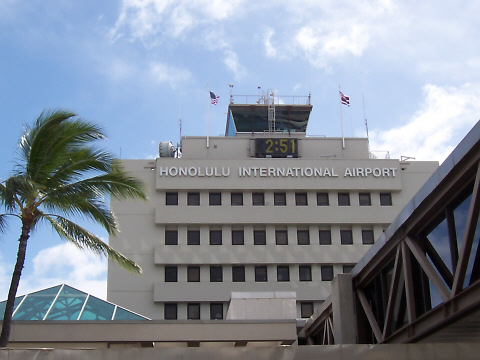 |
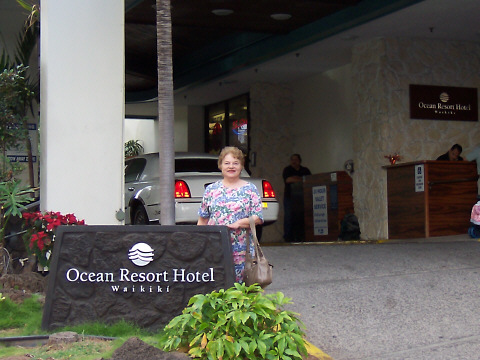 |
Our lodging for the 5 nights on Oahu was a high-rise hotel. Sort of a mid-range one, a couple of blocks from the beach. Parking, as with all the hotels, was valet at $15.00 a day. And for what we wanted to do a car was necessary. I'd estimate at least half those staying here didn't get a car. |
The room was a "Diamond Head View" with a kitchenette. That really helped. Eating out for all meals gets very expensive. But the first night we did eat at the hotel restaurant which featured 'early bird' specials before 6 pm. As that hour was like 10 pm to us due to jet lag we had no trouble with an early dinner. The view from the Lanai (porch) was of Diamond Head. If only that other hotel was a few floors lower.... |
 |
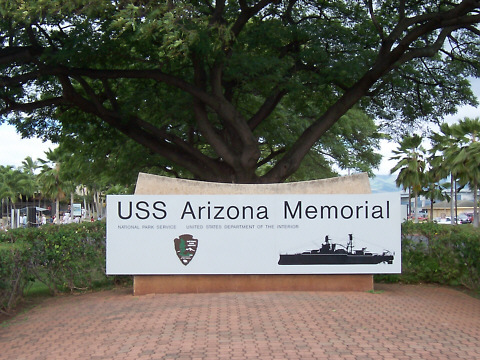 |
Everyone who visits Honolulu should visit the USS Arizona Memorial, a memorial to December 7th, 1941. Even if you don't have a car, there are dozens of tour bus companies that will take you there. We made our visit the first full day we were in Hawaii. The Arizona Memorial is a National Park. Other nearby exhibits are the nearby USS Blowfish submarine and the USS Missouri which is docked at Ford Island. |
The Arizona Memorial is next to Ford Island, where the USS Arizona was docked when it was sunk by the Japanese attack. The US Navy runs the boat that takes tourists across the harbor. It was very well organized, and I imagine it's considered good duty for the sailors involved. |
 |
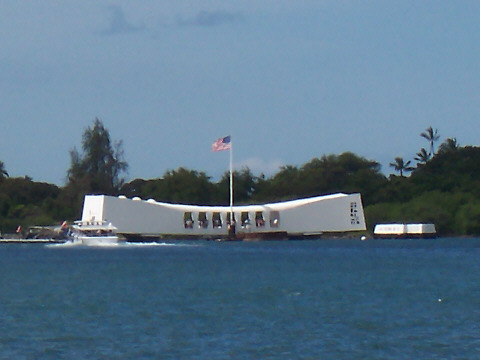 |
It's just a short ride to the memorial and during the trip you can imagine how it the harbor looked over 67 years ago. That small white object to the right of the memorial is the quay to which the Arizona was tied. There are others along Ford Island, each with the name of the battleship that was docked there. |
The memorial actually straddles the sunken hull of the ship. The windows let visitors see the ship. That platform with two tie posts is not part of the ship, but was installed later to facilitate salvage work done after the attack. The United States flag flies from a pole mounted on the severed mainmast of the Arizona. |
 |
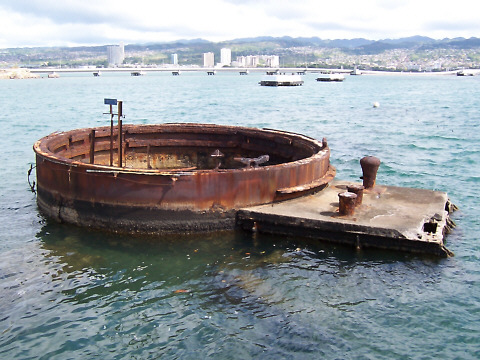 |
This is base of one of the battery turrets; the turrets and guns were removed and used for coastal defense. The other turret bases are below water. Two more white quays can be seen in the distance. The small round buoy just beyond the turret marks the fore end of the Arizona. |
Much of the interior of memorial is open, allowing visitors to move from window to window to see the ship. A fenced opening in the floor gives a view of part of the port side of the ship. |
 |
 |
Although this picture through the floor 'window' doesn't show much, it is much better in person when you can move about a little to avoid the sunlight on the water. |
Shown here are both the USS Missouri battleship and the USS Arizona Memorial. We didn't visit the Missouri but it is open to the public through the Battleship Missouri Memorial organization. It's quite fitting both ships should be here. As the attack that sank the Arizona marked the beginning of the war in the Pacific, the September 2, 1945 Japanese surrender ceremony aboard the Missouri marked the end World War II in the Pacific. |
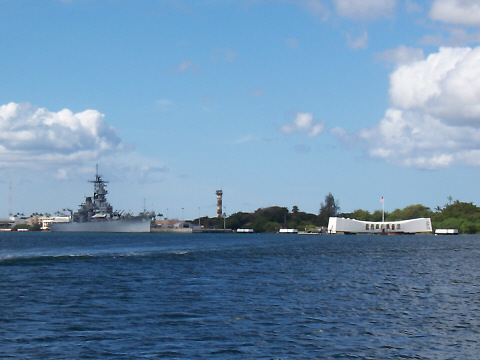 |
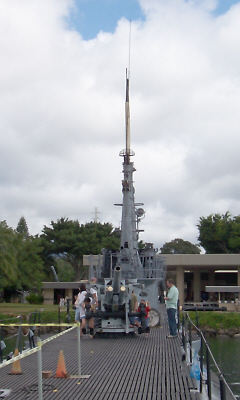 |
Next door to the Arizona Memorial is the USS Bowfin Submarine Museum and Park. For the tour of the submarine you're given headphones and a digital audio player. Numbers are posted throughout the boat and when you enter those into the player keypad you'll hear a description of the location. This is a view of the sail and the 5 inch gun. The gun was especially designed so it could be submerged without damage. |
This is the crew galley. It's quite small but efficient. There were 70 enlisted men in the crew, although not all ate at once. |
 |
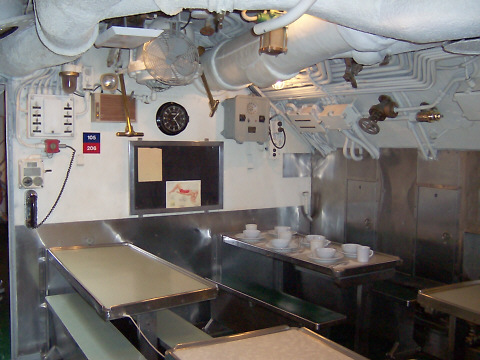 |
The enlisted mess is also small, and all furniture is bolted to the floor. |
Here in the enlisted berthing section it seemed like there weren't enough bunks for all 70 men. But they were 'hot bunks'; that is, bunks were shared by those with different duty hours. Those chained up at an angle were lowered when needed. Space is at a premium on a submarine. |
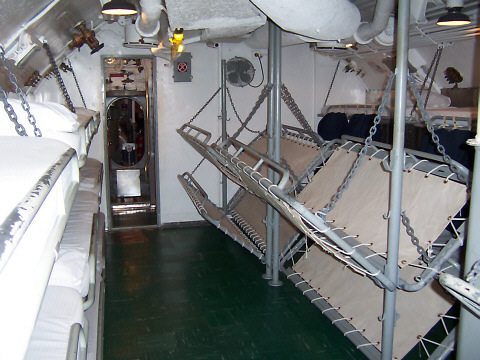 |
 |
This is one of the four General Motors diesel engines that powered the submarine. The engines, used only when on the surface, turned generators which charged the batteries and powered the electric motors which turned two propellers (screws, to sailors who read this). When submerged, the motors were powered from the batteries. |
Although the 5 inch gun on deck is locked in position and disabled, visitors can sit in the gunners seat to get a feel of what it was like. Naturally I couldn't pass it up. |
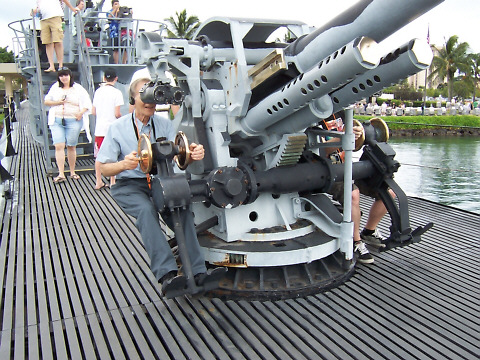 |
 |
We ended our first day excursion with some shopping. Our room had a kitchenette, so stops at a Wal-Mart and a Foodland in Pearl City were necessary. The stop at Pearl City Dairy Queen wasn't necessary but it was welcome. |
Our plan for the next day was to hike to the top of Diamond Head. When we got there, signs said it was closed through Friday. A quick look at our books found another hike so we headed to the Makapu'u Lighthouse Trail. Head there with us by clicking the right arrow below.
| |
|